Organisational Behaviour Report: Structure and Culture of Burberry
VerifiedAdded on 2020/10/23
|11
|3189
|80
Report
AI Summary
This report provides a comprehensive analysis of organisational behaviour, focusing on the Burberry Group as a case study. It begins with an introduction to organisational behaviour and then delves into the different types of public sector organisational structures, including divisional, matrix, vertical, tall, and functional structures. The report further explores the concept of organisational culture, applying Handy's model (power, role, task, and person cultures) to the Burberry Group. An analysis of Burberry's hierarchical structure and power culture is also included. The report then examines the impact and role of central and local government in public services, discussing their responsibilities in terms of budget, spending reviews, funding, legislation, policies, priorities, and procurement. The roles of local government in enforcing laws and providing public services are also discussed. Overall, the report offers a detailed overview of organisational behaviour principles and their application in the public sector, using the Burberry Group as a practical example.
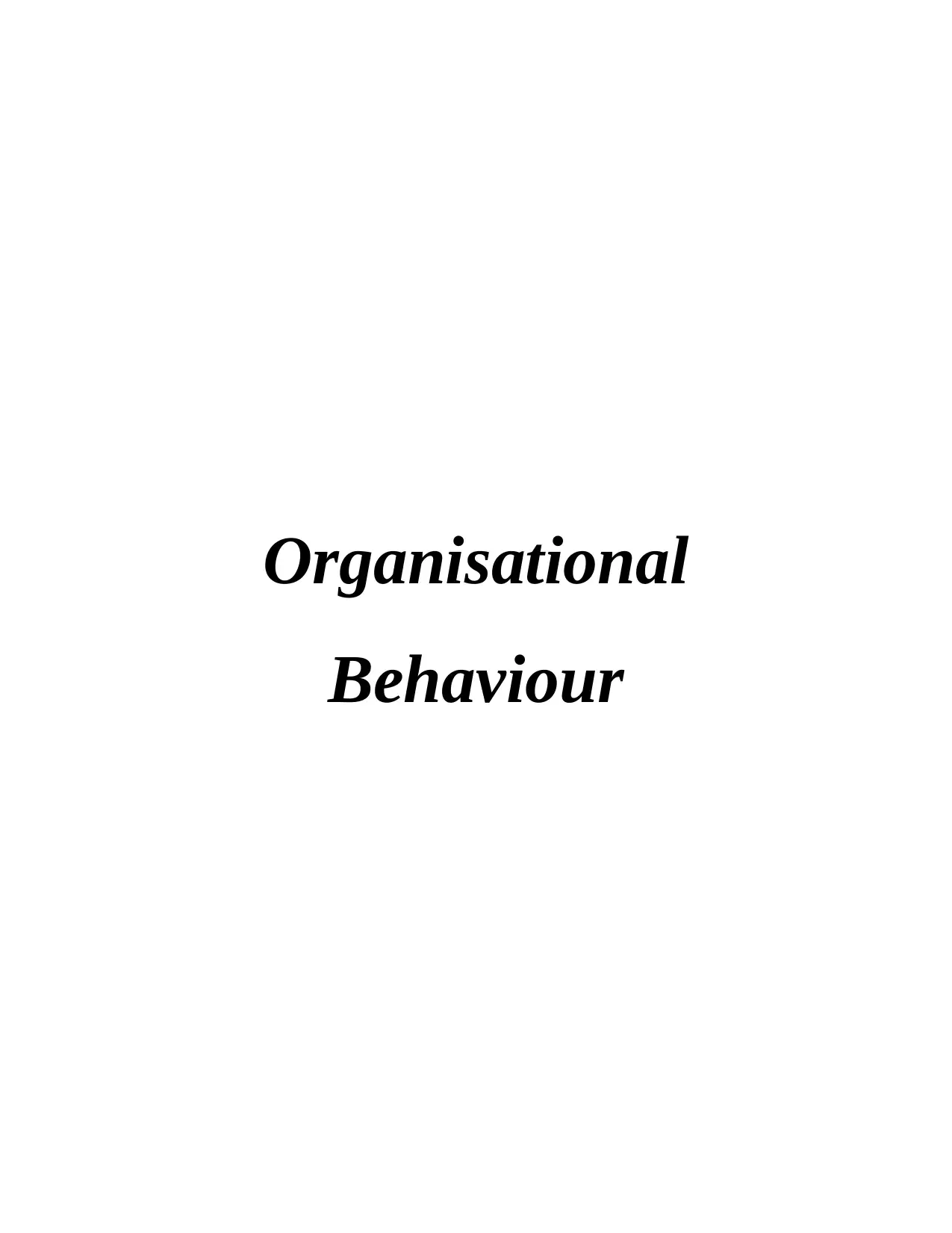
Organisational
Behaviour
Behaviour
Paraphrase This Document
Need a fresh take? Get an instant paraphrase of this document with our AI Paraphraser
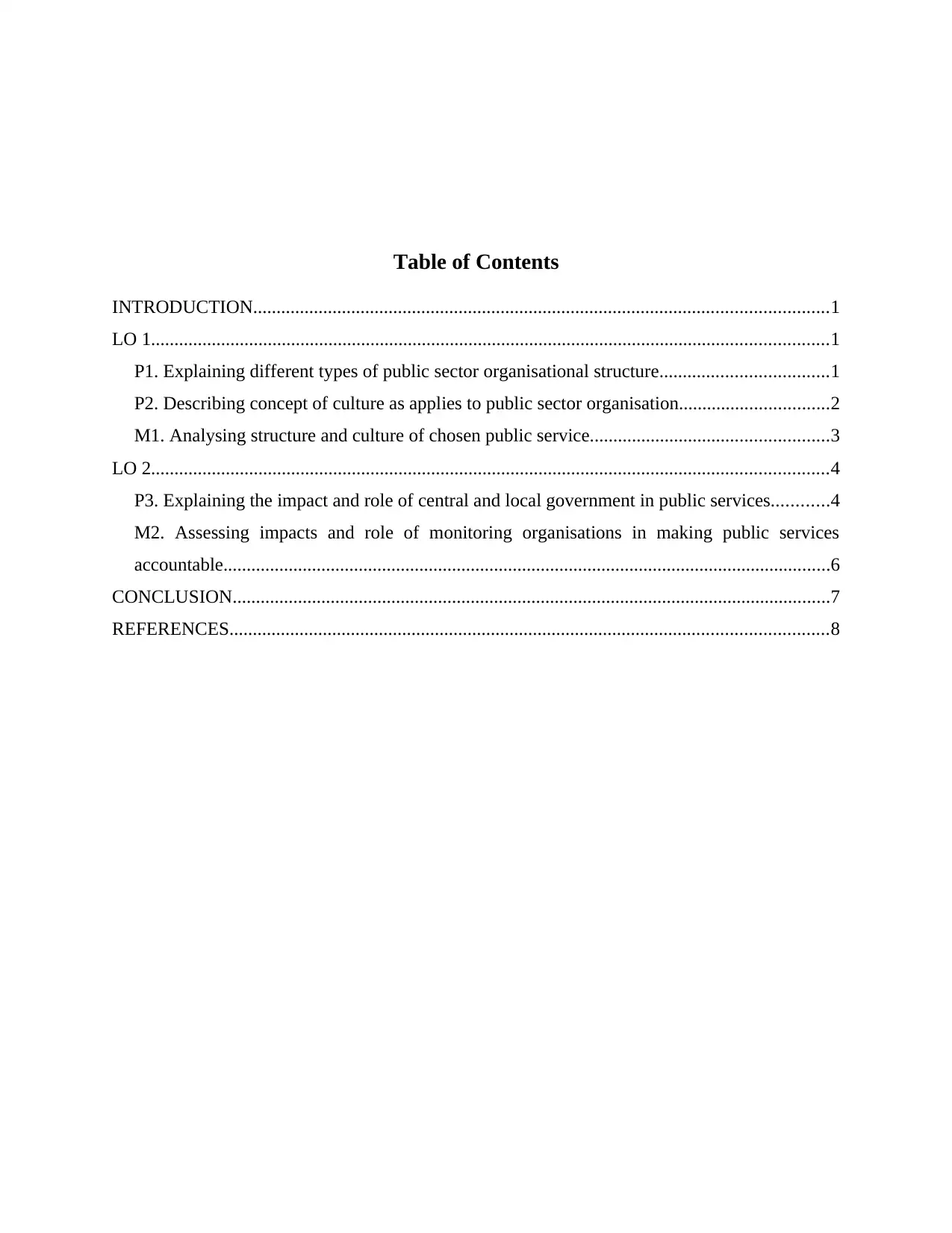
Table of Contents
INTRODUCTION...........................................................................................................................1
LO 1.................................................................................................................................................1
P1. Explaining different types of public sector organisational structure....................................1
P2. Describing concept of culture as applies to public sector organisation................................2
M1. Analysing structure and culture of chosen public service...................................................3
LO 2.................................................................................................................................................4
P3. Explaining the impact and role of central and local government in public services............4
M2. Assessing impacts and role of monitoring organisations in making public services
accountable..................................................................................................................................6
CONCLUSION................................................................................................................................7
REFERENCES................................................................................................................................8
INTRODUCTION...........................................................................................................................1
LO 1.................................................................................................................................................1
P1. Explaining different types of public sector organisational structure....................................1
P2. Describing concept of culture as applies to public sector organisation................................2
M1. Analysing structure and culture of chosen public service...................................................3
LO 2.................................................................................................................................................4
P3. Explaining the impact and role of central and local government in public services............4
M2. Assessing impacts and role of monitoring organisations in making public services
accountable..................................................................................................................................6
CONCLUSION................................................................................................................................7
REFERENCES................................................................................................................................8
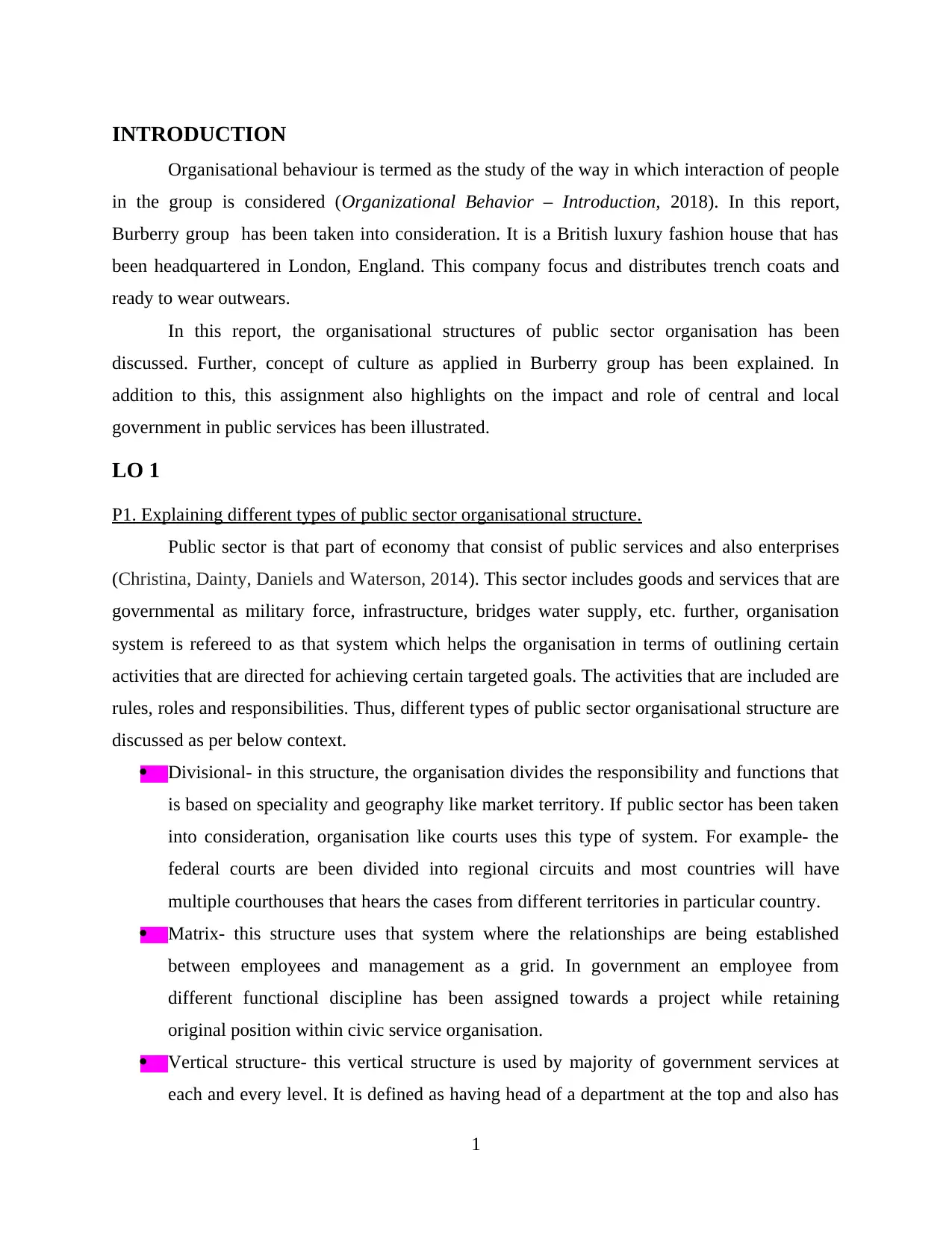
INTRODUCTION
Organisational behaviour is termed as the study of the way in which interaction of people
in the group is considered (Organizational Behavior – Introduction, 2018). In this report,
Burberry group has been taken into consideration. It is a British luxury fashion house that has
been headquartered in London, England. This company focus and distributes trench coats and
ready to wear outwears.
In this report, the organisational structures of public sector organisation has been
discussed. Further, concept of culture as applied in Burberry group has been explained. In
addition to this, this assignment also highlights on the impact and role of central and local
government in public services has been illustrated.
LO 1
P1. Explaining different types of public sector organisational structure.
Public sector is that part of economy that consist of public services and also enterprises
(Christina, Dainty, Daniels and Waterson, 2014). This sector includes goods and services that are
governmental as military force, infrastructure, bridges water supply, etc. further, organisation
system is refereed to as that system which helps the organisation in terms of outlining certain
activities that are directed for achieving certain targeted goals. The activities that are included are
rules, roles and responsibilities. Thus, different types of public sector organisational structure are
discussed as per below context.
Divisional- in this structure, the organisation divides the responsibility and functions that
is based on speciality and geography like market territory. If public sector has been taken
into consideration, organisation like courts uses this type of system. For example- the
federal courts are been divided into regional circuits and most countries will have
multiple courthouses that hears the cases from different territories in particular country.
Matrix- this structure uses that system where the relationships are being established
between employees and management as a grid. In government an employee from
different functional discipline has been assigned towards a project while retaining
original position within civic service organisation.
Vertical structure- this vertical structure is used by majority of government services at
each and every level. It is defined as having head of a department at the top and also has
1
Organisational behaviour is termed as the study of the way in which interaction of people
in the group is considered (Organizational Behavior – Introduction, 2018). In this report,
Burberry group has been taken into consideration. It is a British luxury fashion house that has
been headquartered in London, England. This company focus and distributes trench coats and
ready to wear outwears.
In this report, the organisational structures of public sector organisation has been
discussed. Further, concept of culture as applied in Burberry group has been explained. In
addition to this, this assignment also highlights on the impact and role of central and local
government in public services has been illustrated.
LO 1
P1. Explaining different types of public sector organisational structure.
Public sector is that part of economy that consist of public services and also enterprises
(Christina, Dainty, Daniels and Waterson, 2014). This sector includes goods and services that are
governmental as military force, infrastructure, bridges water supply, etc. further, organisation
system is refereed to as that system which helps the organisation in terms of outlining certain
activities that are directed for achieving certain targeted goals. The activities that are included are
rules, roles and responsibilities. Thus, different types of public sector organisational structure are
discussed as per below context.
Divisional- in this structure, the organisation divides the responsibility and functions that
is based on speciality and geography like market territory. If public sector has been taken
into consideration, organisation like courts uses this type of system. For example- the
federal courts are been divided into regional circuits and most countries will have
multiple courthouses that hears the cases from different territories in particular country.
Matrix- this structure uses that system where the relationships are being established
between employees and management as a grid. In government an employee from
different functional discipline has been assigned towards a project while retaining
original position within civic service organisation.
Vertical structure- this vertical structure is used by majority of government services at
each and every level. It is defined as having head of a department at the top and also has
1
⊘ This is a preview!⊘
Do you want full access?
Subscribe today to unlock all pages.

Trusted by 1+ million students worldwide

middle level managers and positions of low level. The procedures of operation are
dictated by the head of department and plan has been created accordingly by the middle
level managers in order to implement it. Thus, those who are at the positions of lower
level, they will perform the task according to the plan that has been created by the
managers.
Tall structure- it has been characterised by few positions at top and many at the next row
downwards. It is common in professional organisations that includes the firm of law and
architecture. Thus, few government services also use this tall structure. While certain city
adopt this for social services that includes drug prevention or domestic violence
education programs. In addition to this, they do job sharing for the purpose of doing
services. In which staff may work together in cooperate manner differently as compared
to hierarchical order.
Vertical structures- the classic examples of government structure are government
organisations. It has been characterised as few people at top and many and high number
of staffs at middle and lower level of the structure. It can also be defined as few people
make decisions and plans and others carry out. Thus, government leans towards them due
to their creation in terms of job scopes and powers that are well defined. It is one of the
oldest government functions i.e. military command.
Functional structure- it is a set up that each portion is being grouped according to a
purpose. There are various department under this structure that includes marketing
department, sales department finance department etc. thus, this structure works very well
in terms of small business where each and every department rely basically on the talent
and knowledge of the workers that are involved in a particular organisation.
P2. Describing concept of culture as applies to public sector organisation.
The culture of organisations is a social reality that helps employees in creating what they
do and think. The culture is a set of behavioural, emotional and psychological frameworks that
has been adopted by members (Coccia, 2014). Culture means to group the personality to an
individual. Thus, the concept of culture in Burberry group has been discussed as per below
context with the help of Handys model-
Power- If Burberry group adopts power culture, the power will held by just few
individuals who spreads their influence throughout the organisation. The one having the
2
dictated by the head of department and plan has been created accordingly by the middle
level managers in order to implement it. Thus, those who are at the positions of lower
level, they will perform the task according to the plan that has been created by the
managers.
Tall structure- it has been characterised by few positions at top and many at the next row
downwards. It is common in professional organisations that includes the firm of law and
architecture. Thus, few government services also use this tall structure. While certain city
adopt this for social services that includes drug prevention or domestic violence
education programs. In addition to this, they do job sharing for the purpose of doing
services. In which staff may work together in cooperate manner differently as compared
to hierarchical order.
Vertical structures- the classic examples of government structure are government
organisations. It has been characterised as few people at top and many and high number
of staffs at middle and lower level of the structure. It can also be defined as few people
make decisions and plans and others carry out. Thus, government leans towards them due
to their creation in terms of job scopes and powers that are well defined. It is one of the
oldest government functions i.e. military command.
Functional structure- it is a set up that each portion is being grouped according to a
purpose. There are various department under this structure that includes marketing
department, sales department finance department etc. thus, this structure works very well
in terms of small business where each and every department rely basically on the talent
and knowledge of the workers that are involved in a particular organisation.
P2. Describing concept of culture as applies to public sector organisation.
The culture of organisations is a social reality that helps employees in creating what they
do and think. The culture is a set of behavioural, emotional and psychological frameworks that
has been adopted by members (Coccia, 2014). Culture means to group the personality to an
individual. Thus, the concept of culture in Burberry group has been discussed as per below
context with the help of Handys model-
Power- If Burberry group adopts power culture, the power will held by just few
individuals who spreads their influence throughout the organisation. The one having the
2
Paraphrase This Document
Need a fresh take? Get an instant paraphrase of this document with our AI Paraphraser
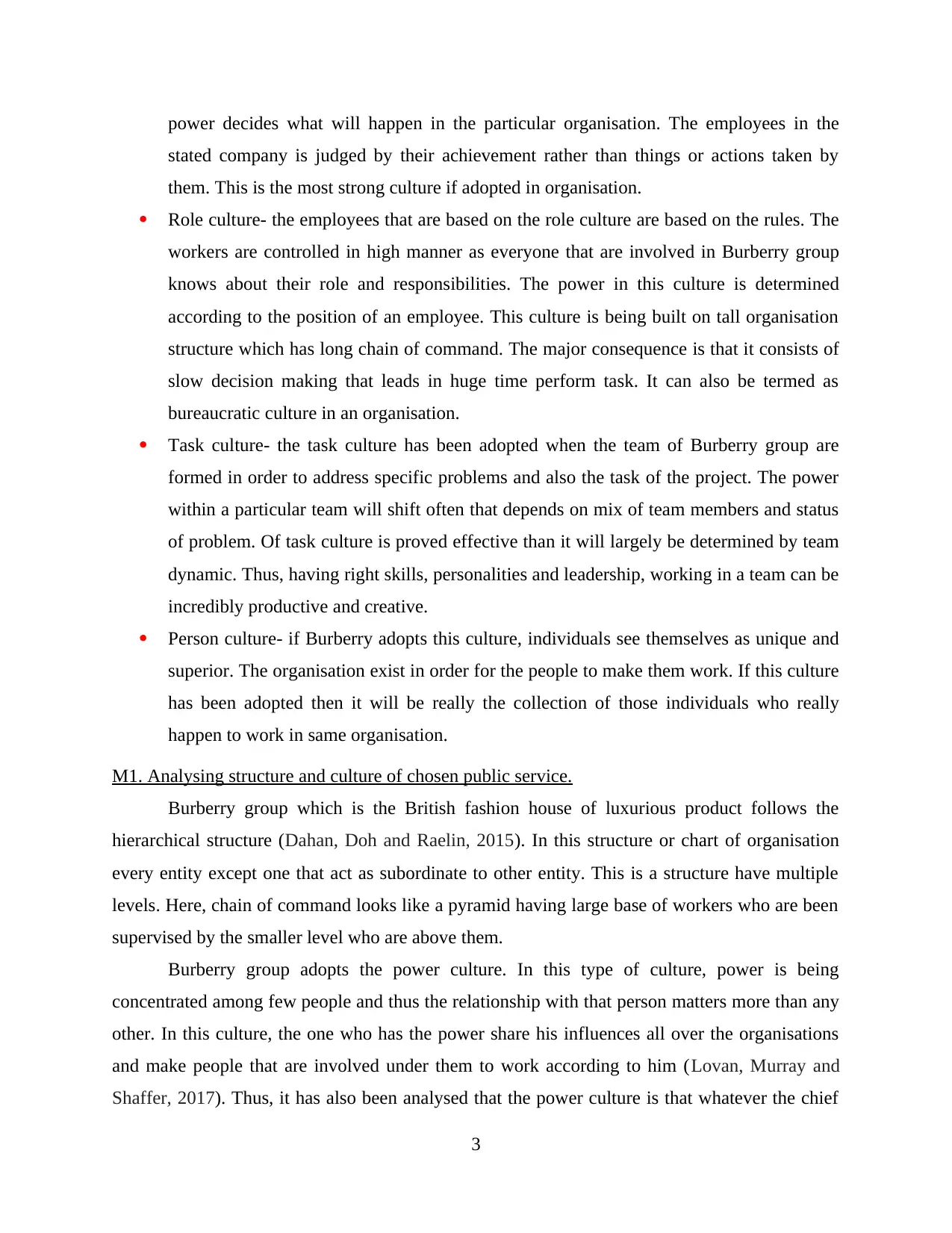
power decides what will happen in the particular organisation. The employees in the
stated company is judged by their achievement rather than things or actions taken by
them. This is the most strong culture if adopted in organisation.
Role culture- the employees that are based on the role culture are based on the rules. The
workers are controlled in high manner as everyone that are involved in Burberry group
knows about their role and responsibilities. The power in this culture is determined
according to the position of an employee. This culture is being built on tall organisation
structure which has long chain of command. The major consequence is that it consists of
slow decision making that leads in huge time perform task. It can also be termed as
bureaucratic culture in an organisation.
Task culture- the task culture has been adopted when the team of Burberry group are
formed in order to address specific problems and also the task of the project. The power
within a particular team will shift often that depends on mix of team members and status
of problem. Of task culture is proved effective than it will largely be determined by team
dynamic. Thus, having right skills, personalities and leadership, working in a team can be
incredibly productive and creative.
Person culture- if Burberry adopts this culture, individuals see themselves as unique and
superior. The organisation exist in order for the people to make them work. If this culture
has been adopted then it will be really the collection of those individuals who really
happen to work in same organisation.
M1. Analysing structure and culture of chosen public service.
Burberry group which is the British fashion house of luxurious product follows the
hierarchical structure (Dahan, Doh and Raelin, 2015). In this structure or chart of organisation
every entity except one that act as subordinate to other entity. This is a structure have multiple
levels. Here, chain of command looks like a pyramid having large base of workers who are been
supervised by the smaller level who are above them.
Burberry group adopts the power culture. In this type of culture, power is being
concentrated among few people and thus the relationship with that person matters more than any
other. In this culture, the one who has the power share his influences all over the organisations
and make people that are involved under them to work according to him (Lovan, Murray and
Shaffer, 2017). Thus, it has also been analysed that the power culture is that whatever the chief
3
stated company is judged by their achievement rather than things or actions taken by
them. This is the most strong culture if adopted in organisation.
Role culture- the employees that are based on the role culture are based on the rules. The
workers are controlled in high manner as everyone that are involved in Burberry group
knows about their role and responsibilities. The power in this culture is determined
according to the position of an employee. This culture is being built on tall organisation
structure which has long chain of command. The major consequence is that it consists of
slow decision making that leads in huge time perform task. It can also be termed as
bureaucratic culture in an organisation.
Task culture- the task culture has been adopted when the team of Burberry group are
formed in order to address specific problems and also the task of the project. The power
within a particular team will shift often that depends on mix of team members and status
of problem. Of task culture is proved effective than it will largely be determined by team
dynamic. Thus, having right skills, personalities and leadership, working in a team can be
incredibly productive and creative.
Person culture- if Burberry adopts this culture, individuals see themselves as unique and
superior. The organisation exist in order for the people to make them work. If this culture
has been adopted then it will be really the collection of those individuals who really
happen to work in same organisation.
M1. Analysing structure and culture of chosen public service.
Burberry group which is the British fashion house of luxurious product follows the
hierarchical structure (Dahan, Doh and Raelin, 2015). In this structure or chart of organisation
every entity except one that act as subordinate to other entity. This is a structure have multiple
levels. Here, chain of command looks like a pyramid having large base of workers who are been
supervised by the smaller level who are above them.
Burberry group adopts the power culture. In this type of culture, power is being
concentrated among few people and thus the relationship with that person matters more than any
other. In this culture, the one who has the power share his influences all over the organisations
and make people that are involved under them to work according to him (Lovan, Murray and
Shaffer, 2017). Thus, it has also been analysed that the power culture is that whatever the chief
3
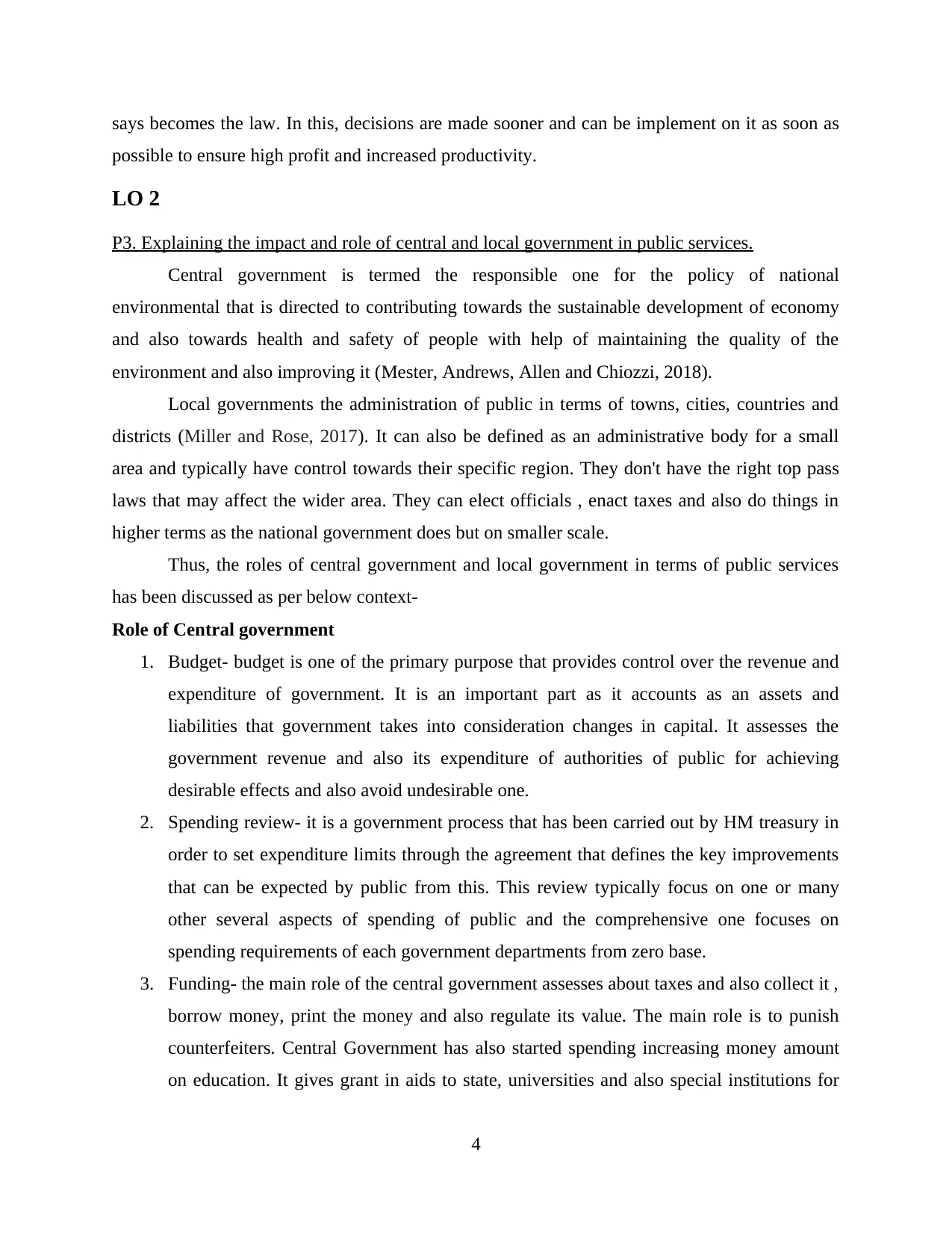
says becomes the law. In this, decisions are made sooner and can be implement on it as soon as
possible to ensure high profit and increased productivity.
LO 2
P3. Explaining the impact and role of central and local government in public services.
Central government is termed the responsible one for the policy of national
environmental that is directed to contributing towards the sustainable development of economy
and also towards health and safety of people with help of maintaining the quality of the
environment and also improving it (Mester, Andrews, Allen and Chiozzi, 2018).
Local governments the administration of public in terms of towns, cities, countries and
districts (Miller and Rose, 2017). It can also be defined as an administrative body for a small
area and typically have control towards their specific region. They don't have the right top pass
laws that may affect the wider area. They can elect officials , enact taxes and also do things in
higher terms as the national government does but on smaller scale.
Thus, the roles of central government and local government in terms of public services
has been discussed as per below context-
Role of Central government
1. Budget- budget is one of the primary purpose that provides control over the revenue and
expenditure of government. It is an important part as it accounts as an assets and
liabilities that government takes into consideration changes in capital. It assesses the
government revenue and also its expenditure of authorities of public for achieving
desirable effects and also avoid undesirable one.
2. Spending review- it is a government process that has been carried out by HM treasury in
order to set expenditure limits through the agreement that defines the key improvements
that can be expected by public from this. This review typically focus on one or many
other several aspects of spending of public and the comprehensive one focuses on
spending requirements of each government departments from zero base.
3. Funding- the main role of the central government assesses about taxes and also collect it ,
borrow money, print the money and also regulate its value. The main role is to punish
counterfeiters. Central Government has also started spending increasing money amount
on education. It gives grant in aids to state, universities and also special institutions for
4
possible to ensure high profit and increased productivity.
LO 2
P3. Explaining the impact and role of central and local government in public services.
Central government is termed the responsible one for the policy of national
environmental that is directed to contributing towards the sustainable development of economy
and also towards health and safety of people with help of maintaining the quality of the
environment and also improving it (Mester, Andrews, Allen and Chiozzi, 2018).
Local governments the administration of public in terms of towns, cities, countries and
districts (Miller and Rose, 2017). It can also be defined as an administrative body for a small
area and typically have control towards their specific region. They don't have the right top pass
laws that may affect the wider area. They can elect officials , enact taxes and also do things in
higher terms as the national government does but on smaller scale.
Thus, the roles of central government and local government in terms of public services
has been discussed as per below context-
Role of Central government
1. Budget- budget is one of the primary purpose that provides control over the revenue and
expenditure of government. It is an important part as it accounts as an assets and
liabilities that government takes into consideration changes in capital. It assesses the
government revenue and also its expenditure of authorities of public for achieving
desirable effects and also avoid undesirable one.
2. Spending review- it is a government process that has been carried out by HM treasury in
order to set expenditure limits through the agreement that defines the key improvements
that can be expected by public from this. This review typically focus on one or many
other several aspects of spending of public and the comprehensive one focuses on
spending requirements of each government departments from zero base.
3. Funding- the main role of the central government assesses about taxes and also collect it ,
borrow money, print the money and also regulate its value. The main role is to punish
counterfeiters. Central Government has also started spending increasing money amount
on education. It gives grant in aids to state, universities and also special institutions for
4
⊘ This is a preview!⊘
Do you want full access?
Subscribe today to unlock all pages.

Trusted by 1+ million students worldwide
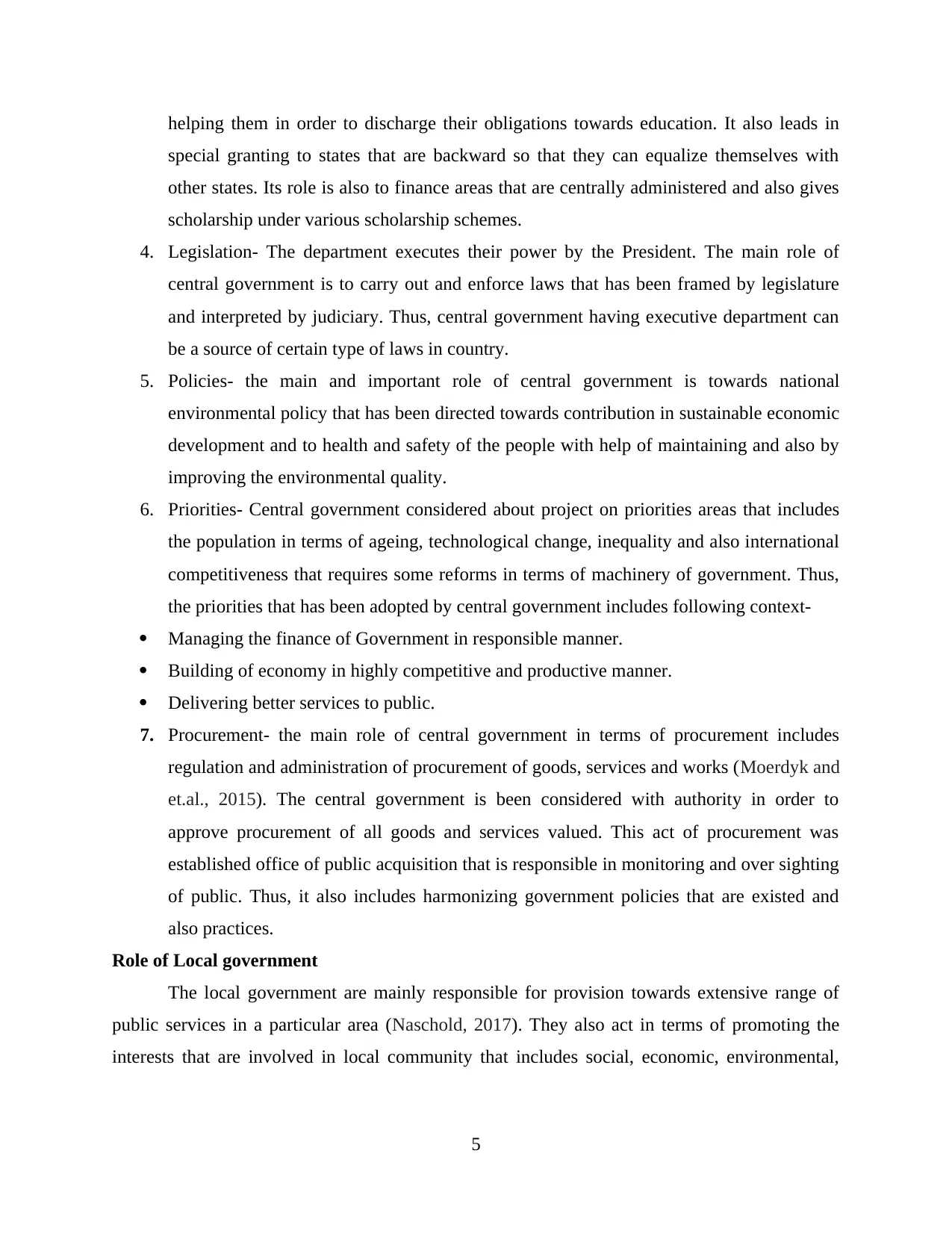
helping them in order to discharge their obligations towards education. It also leads in
special granting to states that are backward so that they can equalize themselves with
other states. Its role is also to finance areas that are centrally administered and also gives
scholarship under various scholarship schemes.
4. Legislation- The department executes their power by the President. The main role of
central government is to carry out and enforce laws that has been framed by legislature
and interpreted by judiciary. Thus, central government having executive department can
be a source of certain type of laws in country.
5. Policies- the main and important role of central government is towards national
environmental policy that has been directed towards contribution in sustainable economic
development and to health and safety of the people with help of maintaining and also by
improving the environmental quality.
6. Priorities- Central government considered about project on priorities areas that includes
the population in terms of ageing, technological change, inequality and also international
competitiveness that requires some reforms in terms of machinery of government. Thus,
the priorities that has been adopted by central government includes following context-
Managing the finance of Government in responsible manner.
Building of economy in highly competitive and productive manner.
Delivering better services to public.
7. Procurement- the main role of central government in terms of procurement includes
regulation and administration of procurement of goods, services and works (Moerdyk and
et.al., 2015). The central government is been considered with authority in order to
approve procurement of all goods and services valued. This act of procurement was
established office of public acquisition that is responsible in monitoring and over sighting
of public. Thus, it also includes harmonizing government policies that are existed and
also practices.
Role of Local government
The local government are mainly responsible for provision towards extensive range of
public services in a particular area (Naschold, 2017). They also act in terms of promoting the
interests that are involved in local community that includes social, economic, environmental,
5
special granting to states that are backward so that they can equalize themselves with
other states. Its role is also to finance areas that are centrally administered and also gives
scholarship under various scholarship schemes.
4. Legislation- The department executes their power by the President. The main role of
central government is to carry out and enforce laws that has been framed by legislature
and interpreted by judiciary. Thus, central government having executive department can
be a source of certain type of laws in country.
5. Policies- the main and important role of central government is towards national
environmental policy that has been directed towards contribution in sustainable economic
development and to health and safety of the people with help of maintaining and also by
improving the environmental quality.
6. Priorities- Central government considered about project on priorities areas that includes
the population in terms of ageing, technological change, inequality and also international
competitiveness that requires some reforms in terms of machinery of government. Thus,
the priorities that has been adopted by central government includes following context-
Managing the finance of Government in responsible manner.
Building of economy in highly competitive and productive manner.
Delivering better services to public.
7. Procurement- the main role of central government in terms of procurement includes
regulation and administration of procurement of goods, services and works (Moerdyk and
et.al., 2015). The central government is been considered with authority in order to
approve procurement of all goods and services valued. This act of procurement was
established office of public acquisition that is responsible in monitoring and over sighting
of public. Thus, it also includes harmonizing government policies that are existed and
also practices.
Role of Local government
The local government are mainly responsible for provision towards extensive range of
public services in a particular area (Naschold, 2017). They also act in terms of promoting the
interests that are involved in local community that includes social, economic, environmental,
5
Paraphrase This Document
Need a fresh take? Get an instant paraphrase of this document with our AI Paraphraser
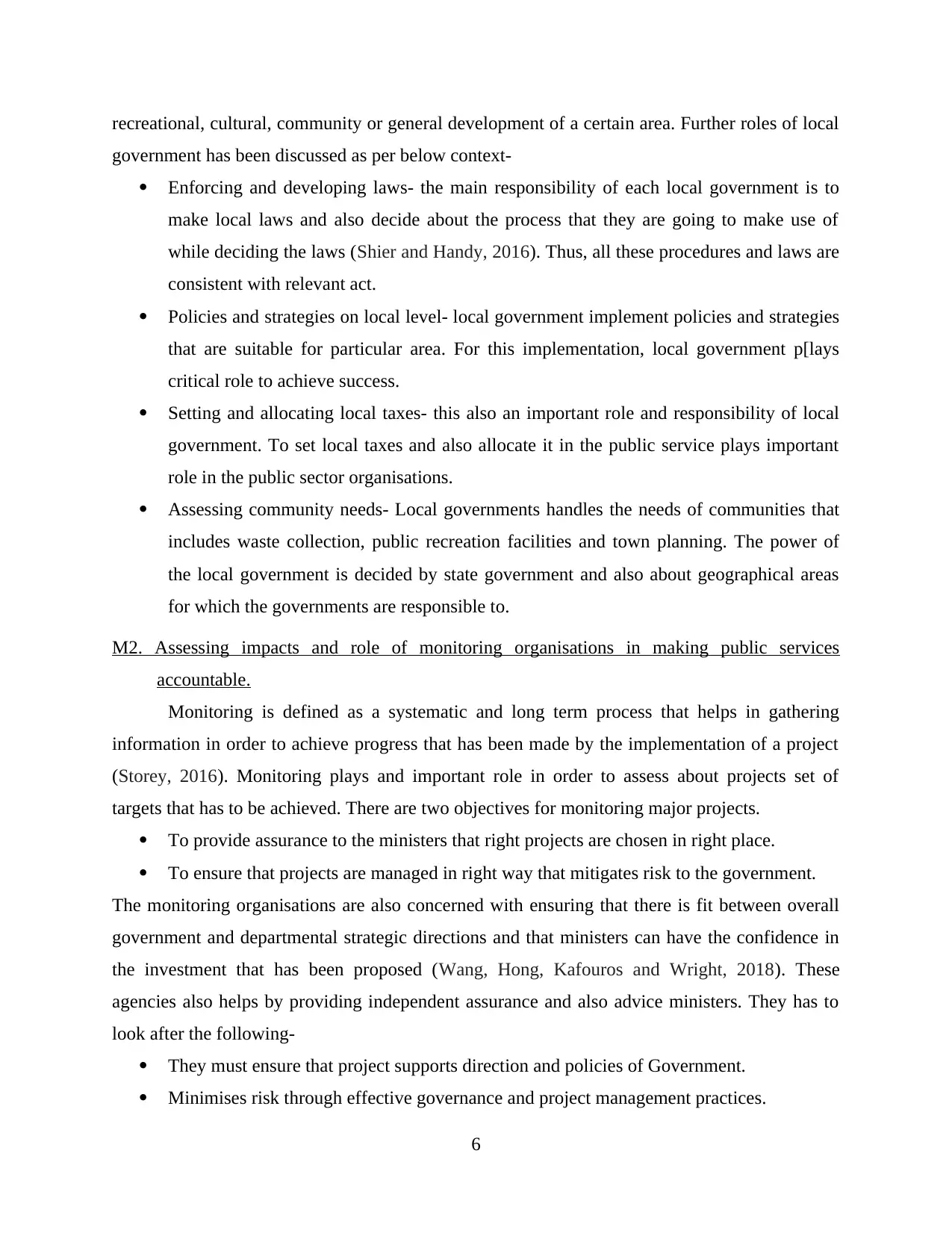
recreational, cultural, community or general development of a certain area. Further roles of local
government has been discussed as per below context-
Enforcing and developing laws- the main responsibility of each local government is to
make local laws and also decide about the process that they are going to make use of
while deciding the laws (Shier and Handy, 2016). Thus, all these procedures and laws are
consistent with relevant act.
Policies and strategies on local level- local government implement policies and strategies
that are suitable for particular area. For this implementation, local government p[lays
critical role to achieve success.
Setting and allocating local taxes- this also an important role and responsibility of local
government. To set local taxes and also allocate it in the public service plays important
role in the public sector organisations.
Assessing community needs- Local governments handles the needs of communities that
includes waste collection, public recreation facilities and town planning. The power of
the local government is decided by state government and also about geographical areas
for which the governments are responsible to.
M2. Assessing impacts and role of monitoring organisations in making public services
accountable.
Monitoring is defined as a systematic and long term process that helps in gathering
information in order to achieve progress that has been made by the implementation of a project
(Storey, 2016). Monitoring plays and important role in order to assess about projects set of
targets that has to be achieved. There are two objectives for monitoring major projects.
To provide assurance to the ministers that right projects are chosen in right place.
To ensure that projects are managed in right way that mitigates risk to the government.
The monitoring organisations are also concerned with ensuring that there is fit between overall
government and departmental strategic directions and that ministers can have the confidence in
the investment that has been proposed (Wang, Hong, Kafouros and Wright, 2018). These
agencies also helps by providing independent assurance and also advice ministers. They has to
look after the following-
They must ensure that project supports direction and policies of Government.
Minimises risk through effective governance and project management practices.
6
government has been discussed as per below context-
Enforcing and developing laws- the main responsibility of each local government is to
make local laws and also decide about the process that they are going to make use of
while deciding the laws (Shier and Handy, 2016). Thus, all these procedures and laws are
consistent with relevant act.
Policies and strategies on local level- local government implement policies and strategies
that are suitable for particular area. For this implementation, local government p[lays
critical role to achieve success.
Setting and allocating local taxes- this also an important role and responsibility of local
government. To set local taxes and also allocate it in the public service plays important
role in the public sector organisations.
Assessing community needs- Local governments handles the needs of communities that
includes waste collection, public recreation facilities and town planning. The power of
the local government is decided by state government and also about geographical areas
for which the governments are responsible to.
M2. Assessing impacts and role of monitoring organisations in making public services
accountable.
Monitoring is defined as a systematic and long term process that helps in gathering
information in order to achieve progress that has been made by the implementation of a project
(Storey, 2016). Monitoring plays and important role in order to assess about projects set of
targets that has to be achieved. There are two objectives for monitoring major projects.
To provide assurance to the ministers that right projects are chosen in right place.
To ensure that projects are managed in right way that mitigates risk to the government.
The monitoring organisations are also concerned with ensuring that there is fit between overall
government and departmental strategic directions and that ministers can have the confidence in
the investment that has been proposed (Wang, Hong, Kafouros and Wright, 2018). These
agencies also helps by providing independent assurance and also advice ministers. They has to
look after the following-
They must ensure that project supports direction and policies of Government.
Minimises risk through effective governance and project management practices.
6
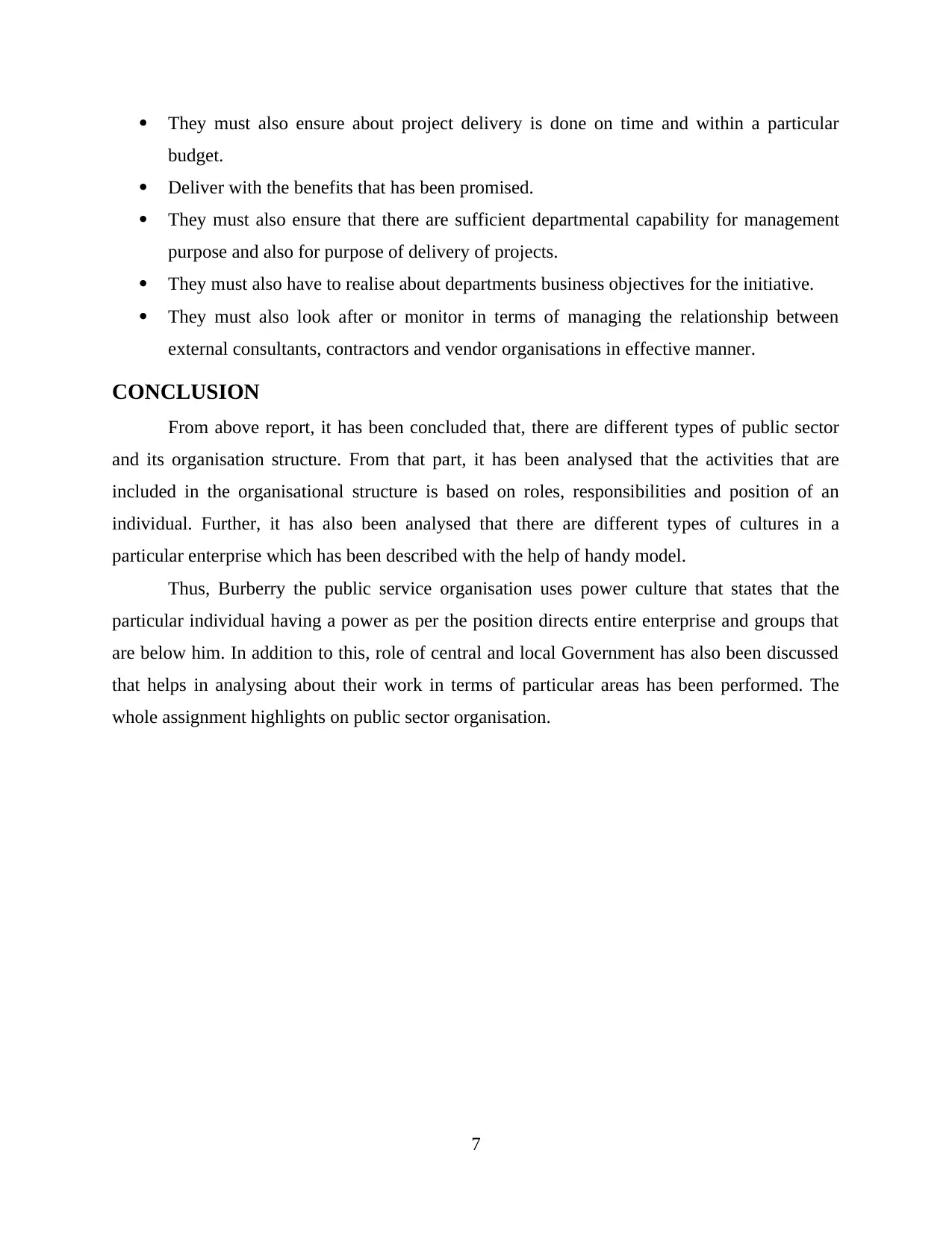
They must also ensure about project delivery is done on time and within a particular
budget.
Deliver with the benefits that has been promised.
They must also ensure that there are sufficient departmental capability for management
purpose and also for purpose of delivery of projects.
They must also have to realise about departments business objectives for the initiative.
They must also look after or monitor in terms of managing the relationship between
external consultants, contractors and vendor organisations in effective manner.
CONCLUSION
From above report, it has been concluded that, there are different types of public sector
and its organisation structure. From that part, it has been analysed that the activities that are
included in the organisational structure is based on roles, responsibilities and position of an
individual. Further, it has also been analysed that there are different types of cultures in a
particular enterprise which has been described with the help of handy model.
Thus, Burberry the public service organisation uses power culture that states that the
particular individual having a power as per the position directs entire enterprise and groups that
are below him. In addition to this, role of central and local Government has also been discussed
that helps in analysing about their work in terms of particular areas has been performed. The
whole assignment highlights on public sector organisation.
7
budget.
Deliver with the benefits that has been promised.
They must also ensure that there are sufficient departmental capability for management
purpose and also for purpose of delivery of projects.
They must also have to realise about departments business objectives for the initiative.
They must also look after or monitor in terms of managing the relationship between
external consultants, contractors and vendor organisations in effective manner.
CONCLUSION
From above report, it has been concluded that, there are different types of public sector
and its organisation structure. From that part, it has been analysed that the activities that are
included in the organisational structure is based on roles, responsibilities and position of an
individual. Further, it has also been analysed that there are different types of cultures in a
particular enterprise which has been described with the help of handy model.
Thus, Burberry the public service organisation uses power culture that states that the
particular individual having a power as per the position directs entire enterprise and groups that
are below him. In addition to this, role of central and local Government has also been discussed
that helps in analysing about their work in terms of particular areas has been performed. The
whole assignment highlights on public sector organisation.
7
⊘ This is a preview!⊘
Do you want full access?
Subscribe today to unlock all pages.

Trusted by 1+ million students worldwide
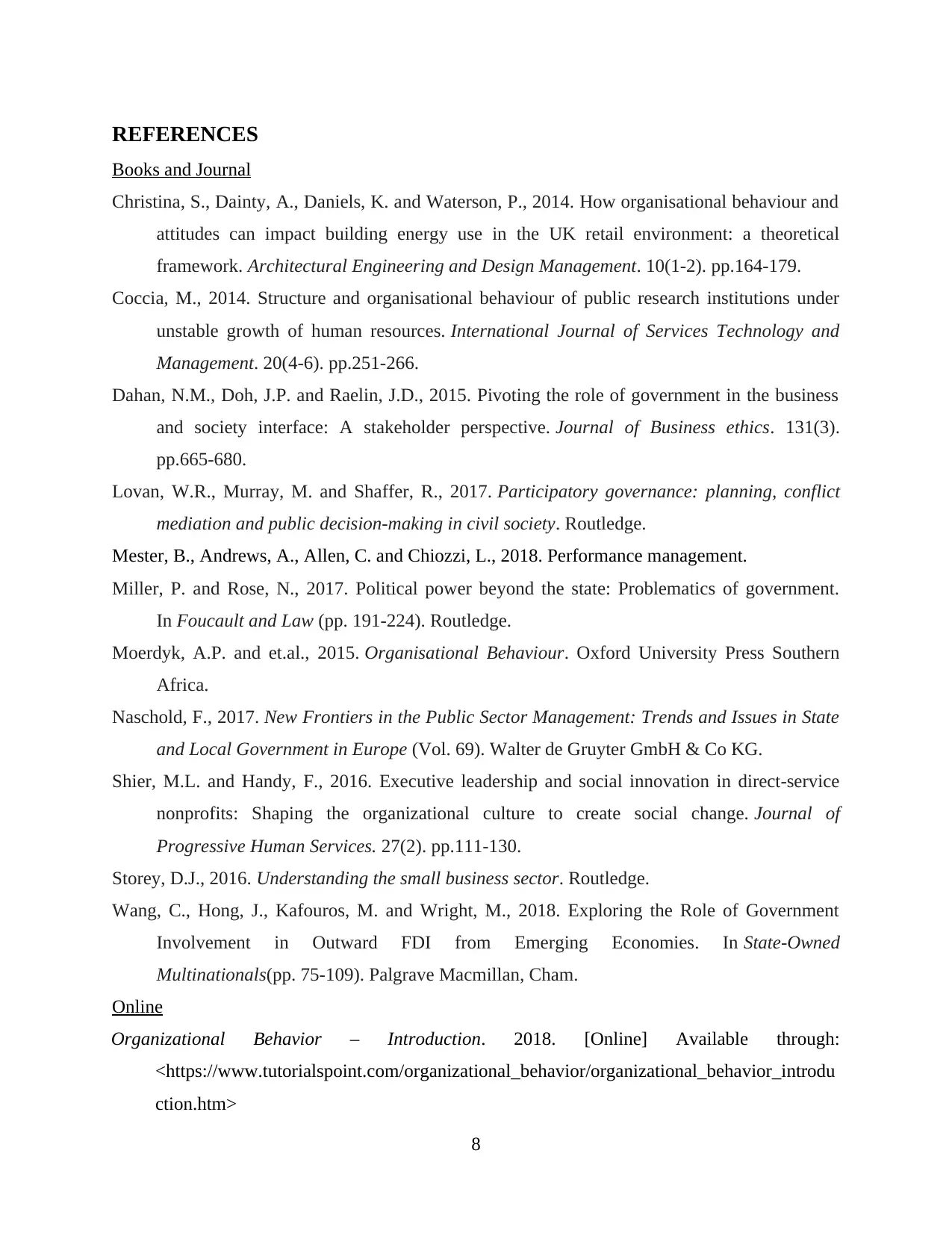
REFERENCES
Books and Journal
Christina, S., Dainty, A., Daniels, K. and Waterson, P., 2014. How organisational behaviour and
attitudes can impact building energy use in the UK retail environment: a theoretical
framework. Architectural Engineering and Design Management. 10(1-2). pp.164-179.
Coccia, M., 2014. Structure and organisational behaviour of public research institutions under
unstable growth of human resources. International Journal of Services Technology and
Management. 20(4-6). pp.251-266.
Dahan, N.M., Doh, J.P. and Raelin, J.D., 2015. Pivoting the role of government in the business
and society interface: A stakeholder perspective. Journal of Business ethics. 131(3).
pp.665-680.
Lovan, W.R., Murray, M. and Shaffer, R., 2017. Participatory governance: planning, conflict
mediation and public decision-making in civil society. Routledge.
Mester, B., Andrews, A., Allen, C. and Chiozzi, L., 2018. Performance management.
Miller, P. and Rose, N., 2017. Political power beyond the state: Problematics of government.
In Foucault and Law (pp. 191-224). Routledge.
Moerdyk, A.P. and et.al., 2015. Organisational Behaviour. Oxford University Press Southern
Africa.
Naschold, F., 2017. New Frontiers in the Public Sector Management: Trends and Issues in State
and Local Government in Europe (Vol. 69). Walter de Gruyter GmbH & Co KG.
Shier, M.L. and Handy, F., 2016. Executive leadership and social innovation in direct-service
nonprofits: Shaping the organizational culture to create social change. Journal of
Progressive Human Services. 27(2). pp.111-130.
Storey, D.J., 2016. Understanding the small business sector. Routledge.
Wang, C., Hong, J., Kafouros, M. and Wright, M., 2018. Exploring the Role of Government
Involvement in Outward FDI from Emerging Economies. In State-Owned
Multinationals(pp. 75-109). Palgrave Macmillan, Cham.
Online
Organizational Behavior – Introduction. 2018. [Online] Available through:
<https://www.tutorialspoint.com/organizational_behavior/organizational_behavior_introdu
ction.htm>
8
Books and Journal
Christina, S., Dainty, A., Daniels, K. and Waterson, P., 2014. How organisational behaviour and
attitudes can impact building energy use in the UK retail environment: a theoretical
framework. Architectural Engineering and Design Management. 10(1-2). pp.164-179.
Coccia, M., 2014. Structure and organisational behaviour of public research institutions under
unstable growth of human resources. International Journal of Services Technology and
Management. 20(4-6). pp.251-266.
Dahan, N.M., Doh, J.P. and Raelin, J.D., 2015. Pivoting the role of government in the business
and society interface: A stakeholder perspective. Journal of Business ethics. 131(3).
pp.665-680.
Lovan, W.R., Murray, M. and Shaffer, R., 2017. Participatory governance: planning, conflict
mediation and public decision-making in civil society. Routledge.
Mester, B., Andrews, A., Allen, C. and Chiozzi, L., 2018. Performance management.
Miller, P. and Rose, N., 2017. Political power beyond the state: Problematics of government.
In Foucault and Law (pp. 191-224). Routledge.
Moerdyk, A.P. and et.al., 2015. Organisational Behaviour. Oxford University Press Southern
Africa.
Naschold, F., 2017. New Frontiers in the Public Sector Management: Trends and Issues in State
and Local Government in Europe (Vol. 69). Walter de Gruyter GmbH & Co KG.
Shier, M.L. and Handy, F., 2016. Executive leadership and social innovation in direct-service
nonprofits: Shaping the organizational culture to create social change. Journal of
Progressive Human Services. 27(2). pp.111-130.
Storey, D.J., 2016. Understanding the small business sector. Routledge.
Wang, C., Hong, J., Kafouros, M. and Wright, M., 2018. Exploring the Role of Government
Involvement in Outward FDI from Emerging Economies. In State-Owned
Multinationals(pp. 75-109). Palgrave Macmillan, Cham.
Online
Organizational Behavior – Introduction. 2018. [Online] Available through:
<https://www.tutorialspoint.com/organizational_behavior/organizational_behavior_introdu
ction.htm>
8
Paraphrase This Document
Need a fresh take? Get an instant paraphrase of this document with our AI Paraphraser

9
1 out of 11
Related Documents
Your All-in-One AI-Powered Toolkit for Academic Success.
+13062052269
info@desklib.com
Available 24*7 on WhatsApp / Email
![[object Object]](/_next/static/media/star-bottom.7253800d.svg)
Unlock your academic potential
Copyright © 2020–2025 A2Z Services. All Rights Reserved. Developed and managed by ZUCOL.





